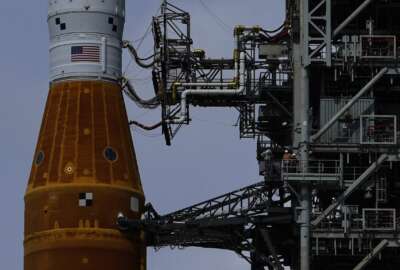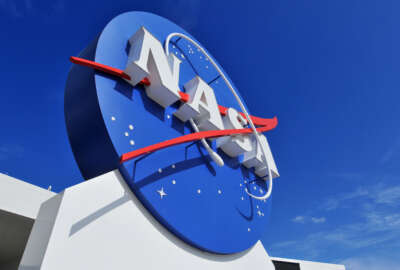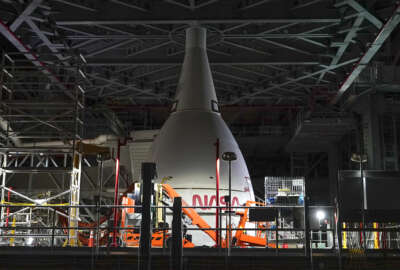What it’s really like on the planet Venus? Ask this NASA scientist
NASA researcher Lori Glaze is focused on the nearby planets and their geologic behavior.
Meet the career NASA researcher who’s focused on the nearby planets and their geologic behavior. Lori Glaze is director of the Planetary Science Division of NASA’s Science Mission Directorate. She spoke to the Federal Drive with Tom Temin host on the Space Hour.
Interview Transcript:
Tom Temin Work, planetary geologic behavior. That’s volcanoes and the movement of the surface and things happening on the planets. Tell us more about the purpose of that research.
Lori Glaze Well, a lot of what we’re interested in is trying to understand how all of the planets formed and how they evolved and changed over time. And of course, volcanism is a major process that happens on the Earth and on Mars and the moon and Mercury and Venus, all of the terrestrial planets. And so that’s really trying to understand how volcanism has shaped what those planets look like today.
Tom Temin So you’re basically a dermatologist of the planet.
Lori Glaze Kind of. Yeah. Understanding the surface of the planets.
Tom Temin And how does that inform the missions, or is it just the pure science to understand that is the mission?
Lori Glaze So that’s a part of what we’re trying to understand. And we’re really trying to understand the planets as a whole and the roles they’ve played in our solar system formation and the evolution of the solar system. So, our missions from NASA, we take the next step from looking through a telescope. We actually send spacecraft to the planets to look up close, either orbiting around the planets, I mean, getting lots of images so we can understand the planets from images and other geophysical information. Or sometimes we land missions like Perseverance rover that’s now driving around on the surface of Mars. And that’s another way that we can explore.
Tom Temin By the way, my own ignorance. Have we landed anywhere else besides the moon and Mars.
Lori Glaze At this point? Those are the major planets we’ve landed on. Although there was a European lander that landed on a comet, and we actually have sent a couple little landers, or I think JAXA sent a couple of landers, that’s Japan Agency sent someone to an asteroid. But yeah, the main planets would be the moon and Mars.
Tom Temin And speaking of asteroids, that’s another area of interest for you, the near-Earth object that, yeah, I guess potentially could endanger the Earth.
Lori Glaze Yeah, that’s a big part of our program. We call it planetary defense. We’re planetary defenders, meaning that we’re on the lookout all the time looking for asteroids or comets that could eventually, perhaps run into Earth and be dangerous for us here. We don’t want to experience something like the mass extinction that happened, the big asteroid impact that wiped out the dinosaurs. So, we’re looking out for those big ones. And then just last year, we tested a mission called the Double Asteroid Redirection Test, where we actually, on purpose, crashed a spacecraft into an asteroid so that we could see just how well we could change its orbit.
Tom Temin Right. And we found that even that little bit of impact an inch in space is millions of miles by the time the thing gets here.
Lori Glaze Exactly. If you have enough time, that little, tiny change over time turns into a big difference. And for planetary defense, our goal is to make sure that when that asteroid passes over Earth’s orbit, Earth is out of the way. We’ve already moved, and it comes in behind us instead of smashing into us.
Tom Temin Sure. And as a girl, were you the type of child who, when everyone else got Barbie dolls for Christmas, you got a telescope?
Lori Glaze Well, actually, no, I was still into Barbie dolls, but I was always really into math and science, so I really did enjoy building sets and things like that, L egos and erector sets and things like that. I was really into that. Both of my parents were engineers. My brother ended up being an engineer, so lived in a household that was pretty conducive to that sort of thing.
Tom Temin And when looking at the planets, I mean, we still use telescopes. How much of the research is observation and how much is calculation if that makes sense?
Lori Glaze Well, that’s a really good question. And particularly for myself, my personal background, my research area was in the kind of theoretical research I did a lot of modeling work, meaning that I would develop a mathematical equation that could describe how a lava flow moves on the surface of Mars. And then I would use imaging data from our spacecraft to compare with my model, to help us better understand how those volcanoes would have worked on Mars in the past. So, it kind of all works together.
Tom Temin Right, so on Earth, volcano flows have a certain characteristic. And then if you build in the factors of temperature, gravity, atmospheric makeup, you can then maybe extrapolate what would happen on Mars if we could watch a volcano.
Lori Glaze That is exactly right. And then we can see today lava flows on Mars that erupted millions of years ago. We can see what they look like when they finished flowing, and we can use our models to work backwards and tell us, well, what would that have looked like? You know, again, changing the gravity and the atmospheric conditions and that sort of thing. How would that have erupted? What would it have looked like while it was erupting? And what can that tell us about how volcanoes work on Mars?
Tom Temin I’m getting the whiff of artificial intelligence coming into this type of work.
Lori Glaze It could eventually.
Tom Temin All right. We’re speaking with Doctor Lori Glaze. She’s director of the Planetary Science division at NASA and a Presidential Rank Award winner. And why did they pick you for a rank award? Come on. I mean, you’re one of a couple of hundred. So, you’re an elite person here?
Lori Glaze Yeah. Well, I will tell you the things that went into my nomination this go round were that, you know, we recently went through the depths of a pandemic. And one of the things that we were able to do that I was able to help my organization during that pandemic was to make sure we got that. Mars Perseverance rover launched. It launched in July of 2020. So many of us may recall that in March of 2020, we were all sent home. But that was kind of at the peak time that that mission really needed to finish all of the final integration of all the piece parts. We shipped the spacecraft to Florida to be integrated onto the rocket that was going to launch from Cape Canaveral. And that was really hard to do. We had to basically mobilize the entire agency to make sure we had safe at work practices for all of the individuals we you know, we put people’s health first and foremost, certainly above the launch of a spacecraft. But as stewards of taxpayers’ dollars, we recognize if we missed a launch date, you could only go to Mars every two years. And that’s fairly expensive to wait another.
Tom Temin I mean, it’s hundreds of millions of dollars.
Lori Glaze Hundreds of millions of dollars. You’re exactly right. So, we didn’t want to do that. So, we worked really hard to keep our personnel safe. We worked on ways to transport them across the country so that, again, they kept their health and didn’t put them at risk. And we were able to successfully launch that mission, as well as two others that came along a little later than that, but still had the bulk of that work going on during the pandemic. And that was a big part. There were other things as well, but that was one of the main things.
Tom Temin So you had a challenge maybe similar to, say, the FAA, where people have to operate consoles and monitor things in close proximity to one another. Did the technology available as of 2020 enable people to do some of this remotely, as it did in a lot of industries actually,?
Lori Glaze We did move a lot of the work to be remote. A lot of the workforce, you can imagine software development were things that we were able to move those folks’ home, and they were able to stay at home and stay safe and complete that work in a remote environment. But a lot of our work is hands on. When you’re getting ready to launch a spacecraft, it is hands on people in what we call a clean room. So, we already have processes that we require when we assemble spacecraft, they have to be dressed in what we call a bunny suit with masks and gloves and hats and, you know, the whole thing. But we had to then work the protocols for how we made sure as they transitioned into those clean rooms, that everyone was healthy and safe and not interacting with each other. And, you know, so we put a lot of extra steps in the process.
Tom Temin Yeah. Because clean room gear, say in semiconductor manufacturing or something like this, the particulates they worry about are much smaller, I think, than the microbes that are harming people. So, once they were in there, okay. Has the robotic capability of the rover been able to take its mask off?
Lori Glaze It definitely took its mask off. As soon as it landed on Mars, it was ready to go. And Percy’s been doing a great job now since February of 2021. So, we’re coming up almost on three years of activity on surface of Mars, doing an amazing job.
Tom Temin And on the research front, let’s get back to that. What are your priorities of the moment? What do you hope to do next? What are you working on?
Lori Glaze So we got a couple of big priority.
Tom Temin I mean, you were a director, so do you still do some research hands on?
Lori Glaze Well, I don’t actually get to do a whole lot of research myself these days, but my role I see is primarily enabling our entire planetary science community across the United States to do the research and can keep that science moving forward. So that’s my main job right now. But I’ll tell you from our division standpoint, from NASA’s standpoint, the next big things for planetary, we’ve got a big mission that’s going to be launching next October. It’s a mission to fly a spacecraft to a moon of Jupiter called Europa. Europa is really exciting. Its ice covered, but beneath the ice is a global ocean that could actually support life today. And so, we’re going to orbit around Jupiter and fly by Europa and understand whether or not that ocean might be habitable. We also have a really big year coming up for the moon. We’ve been working a lot with our human exploration side of the house. Humans of course, we’re working with Artemis that are going to send humans back to the moon, but this year we’re sending several NASA payloads to the surface of the moon in a brand-new program where we’re using commercial capabilities. Brand new commercial companies that have never sent planetary missions before are going to be landing on the moon. And the first two of those are expected to launch in January. So, we’re really excited.
Tom Temin Yeah, so that the planetary in the geologic type of research that your group does, does inform what the missions are doing in terms of sending probes out there.
Lori Glaze Absolutely. It’s the science really, that drives the big questions. And then based on those big questions, NASA determines which missions we want to fly to answer those questions.
Tom Temin And by the way, how big is Europa?
Lori Glaze So Europa is a moon of Jupiter is about the size of our moon, approximately. It’s a pretty cool place. I’ll just mention that part of the big spacecraft that’s going to fly. The Power and Propulsion unit was actually built at Applied Physics Lab, just up the road here in Laurel, Maryland. And I can also just give a quick plug for folks that if you want to send your name on the spacecraft, we have a program called message in a bottle. We’ve got 2 million names already. People are sending their names to Europa. You too can do that.
Tom Temin All right. And just a final question, I guess philosophical or scientific philosophical. But we can calculate what’s going on with a lot of algorithms based on what we know of a planet, and we can observe it from a certain distance, either from Earth or from closer. But in launching a probe that would actually orbit something like Europa, you’re really right there. So that the closeness of observation is really important as well as the calculating side.
Lori Glaze Yeah, it’s incredibly important to be this close. There’s some things that we can do in that proximity that there’s no way we can do from Earth or further away. One of those things is we think that it’s possible there could be geysers on Europa that are spewing out water, that if there were biology in that ocean, might be represented in those geysers. We can fly through those, perhaps, and sample those.
Eric White Dr. Lori Glaze is director of the Planetary Science division at NASA, speaking there with Federal News Networks Tom Temin. That’s going to do it for this month’s episode of The Space Hour. You can find all of today’s interviews and past interviews at Federal News network.com. Search the space hour.
Copyright © 2025 Federal News Network. All rights reserved. This website is not intended for users located within the European Economic Area.
Tom Temin is host of the Federal Drive and has been providing insight on federal technology and management issues for more than 30 years.
Follow @tteminWFED
Eric White is news anchor and Federal Drive producer at Federal News Network.
Follow @FEDERALNEWSCAST







